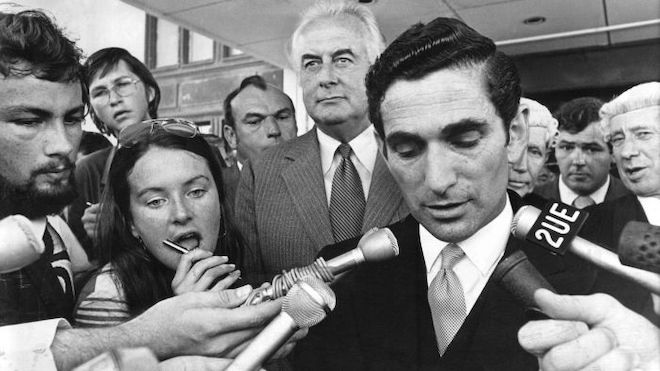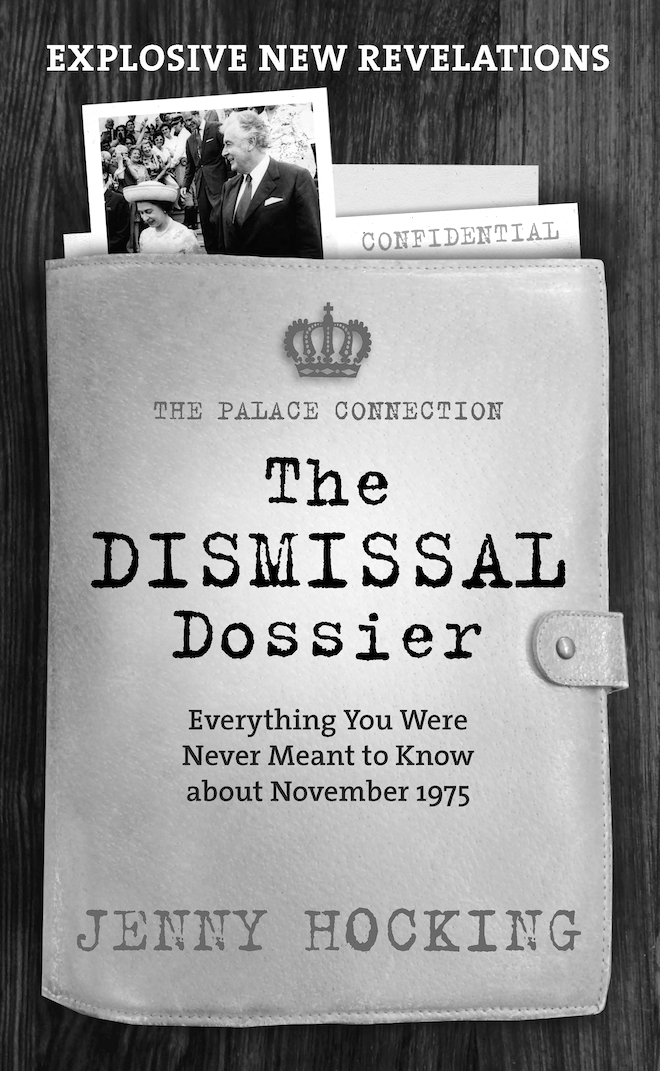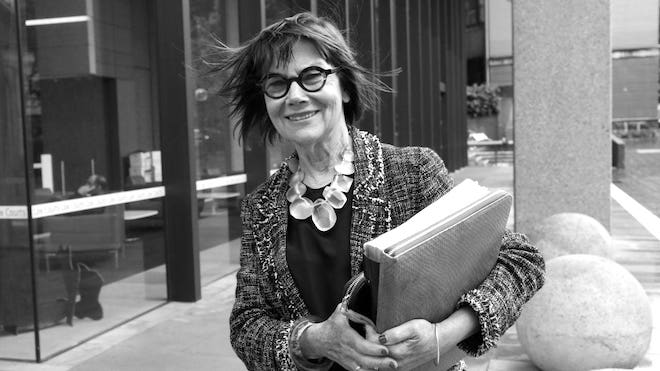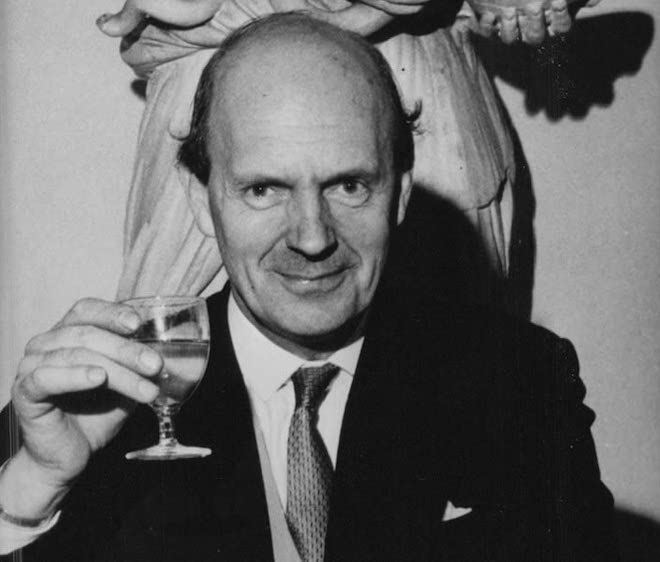Leading hacks at The Australian have waged war on Professor Jenny Hocking and her research into the 1975 dismissal of the Whitlam government by governor general Kerr ... The archived letters clearly confirm the Palace's involvement ... It is The Australian's version that is in need of repair ... Michael White dismantles the claims about Hocking's "conspiracy theory"
Palace letters reveal that Henry II was not informed in advance of Thomas a Becket's murder.
— JohnQuiggin (@JohnQuiggin) July 14, 2020
In 2018, Paul Kelly and Troy Bramston, journalists at The Australian who had written a book on the 1975 dismissal of the Whitlam government by the Governor General Sir John Kerr, appeared close to apoplectic in a commentary on The Dismissal Dossier, Jenny Hocking's book on the same topic.
Hocking's "central claim" was "that our head of state and her advisers at the palace were involved in Whitlam's dismissal".
Indeed, Palace officials were "in deep intrigue" with Kerr "in the weeks before the dismissal". If correct, the "story ... is such an unforgivable abuse of our sovereignty by the Queen that she should forfeit any claim to remain the nation's head of state".
Kelly and Bramston go on to say that given the story was a "direct assault on the integrity of the Queen and governor-general", it was fortunate that it was nonsense, dependent as it was on "a conspiracy theory centred on Buckingham Palace and the British government".
Further, it was alarming that Hocking was not alone in promulgating such abuse of the historical record. Her book reflected "an age of post-truth politics where debate is shaped by emotion and conspiracy theory divorced from facts".
Claims about Hocking's conspiracy theory were ramped up at The Australian following the release of the Palace letters by the National Archives of Australia.
Against the opposition of the Archive, the Palace and the Australian government, Hocking had undertaken a long legal campaign to have the "dismissal" letters between Kerr and the Palace made publicly available.
When the cache was eventually released, Kelly and Bramston declared that the documents had put the final nail in Hocking's conspiracy theory.
 God save The Queen
God save The Queen
The fulcrum of their case was that there had been no conspiracy because it was evident that the Palace was not told by Kerr in advance that he intended to dismiss Whitlam on November 11.
As Kelly and Bramston have been the most prominent and persistent exponents of the conspiracy charge, the purpose of this article is to carefully examine their argument.
Three conclusions are drawn. First, Hocking did not and could not have made the purported claim about a conspiracy. Second, the quotations which have been used from the Dismissal Dossier to support the charge do not do so. Indeed, the way in which they are referred to erases the arguments that Hocking did make. Third, Kelly and Bramston have failed to acknowledge that the Palace letters actually confirmed Hocking's analysis and that it was their own story that now requires serious repair.
1. A conspiracy?
It is evident from the Dossier that there were conspiracies involved in the Dismissal. With Kerr as the focal point, these involved Sir Anthony Mason, Sir Garfield Barwick and Malcolm Fraser. With regard to the Palace, however, Hocking distanced her discussion from a conspiracy theory, observing:
"Lumped in with the 'usual suspects' - the CIA, MI6, ASIO - as a mere conspiracy, the Palace connection has been routinely ignored. Kerr's immediate protestation, that in dismissing Whitlam he had 'protected' the Queen and had ensured the Palace was not involved, has been too readily accepted and too little questioned (Dismissal Dossier, p.xvi)."
The analysis thus turned on examining the precise nature of the connection. And Hocking was clear it did not involve Kerr telling the Palace "in advance" of the timing of the Dismissal. This was because she did not question Kerr's claim that, in his own words, he did not tell "the Queen in advance that I intended to exercise these [reserve] powers on 11 November" (cited Dismissal Dossier, p.12). If Kerr had informed the Palace in advance, a "mere conspiracy" argument could be run. However, precisely because Hocking accepted Kerr's statement, she made a series of other arguments, the formulation of which did not require any reference to a conspiracy.
The critics have ignored Hocking's clear indication she accepted Kerr's claim he did not inform the Palace of the dismissal in advance.
The quotations
Following the release of the Palace letters, Bramston characterised Hocking's analysis as a "madcap" theory, announcing that she had been "humbled and humiliated":
"For five years, historian Jenny Hocking has promulgated the idea that the Queen knew about Gough Whitlam's dismissal in advance and approved it with 'an unqualified royal green light'. This is a scandalous, outrageous and shocking claim. It is unacceptable and untenable that the monarch intervened in Australian politics this way.
Hocking claimed that Kerr's vice-regal letters during the constitutional crisis of October-November 1975 would prove this. The problem is that they do not. The letters, released yesterday by the National Archives of Australia, completely debunk Hocking's conspiracy theory. This is both humbling and humiliating for Hocking."
Hocking had never made such claims. As noted above, it would have been impossible for her to do so because she quoted and did not query Kerr's claim that he had not advised the Palace "in advance".
Nor did she claim that the letters would "prove" a conspiracy. Bramston's column nevertheless is worth further consideration as he purported to provide textual evidence from the Dossier. As he put it:
"Hocking was definitive that the palace had 'advance knowledge' of Kerr's plan to dismiss Whitlam by ambush. She added there was a 'secret arrangement' about a 'well-advanced plan' to terminate Whitlam's prime ministership."
Furthermore, Hocking had claimed the Queen gave an "an unqualified royal green light" to the dismissal. To this can be added Kelly and Bramston's mention (from the 2018 critique cited above) that Hocking had depicted palace officials "in deep intrigue" with Kerr in the weeks before the dismissal.
So there are five quotations to examine, beginning with the "green light" metaphor, which provides some context for considering the others.

A green light
There are two mentions of a "green light" in the Dossier. The first is at page 24, the context for which was an entry Hocking found in Kerr's unpublished journal.
This referred to a report to the Palace by the Prince of Wales regarding a September 1975 conversation he had in New Guinea with Kerr as to whether it was possible that Whitlam could sack Kerr if Kerr tried to sack the Prime Minister.
Kerr wrote that Sir Martin Charteris, private secretary to the Queen, had then told him that, should Whitlam sack him, the Queen would ultimately have to accept it but would "'try to delay things' for as long as possible" (Dismissal Dossier, p.15).
Hocking noted that meant the Palace was aware that Kerr was considering dismissing Whitlam and raised no concern about such a move, nor that Kerr was "communicating directly" with the Palace about it.
Moreover, the Palace did not alert Whitlam that Kerr was canvassing the possibility of sacking him (Dossier, pp.22-3). Hocking concluded that these points and Charteris' "delay as long as possible" information "can only be seen as an unqualified royal green light to Kerr's dismissal of Whitlam" (Dossier, p.24) because a delay would enable Kerr to act against the Prime Minister.
In summary, Hocking argued that, because of the failure to alert Whitlam, "the Palace not only abetted Kerr's deception, it was complicit in it" (Dossier, pp.24, 25).
The conclusion of "complicity" was the core of her argument about the role of the Palace.
The second mention was at p.124. Referring to the same context as for the page 24 quote, Hocking noted that, in the letters between Kerr and Charteris:
"Kerr certainly took their secret communications not only as a Royal green light for his continuing deception of Whitlam - after all, the Palace was doing the same - but as a Royal decree to do his 'duty' and protect the Queen."
Bramston does not indicate which of these quotes he is referring to. But, read in context, the "green light" metaphor refers to the deception of Whitlam by Kerr and the Palace regarding Kerr canvassing the possibility of sacking Whitlam.
At no point did Hocking refer to a "conspiracy" with Kerr informing the Palace about the date of the dismissal. Rather, she concluded that the Palace was "complicit" in Kerr's actions.
It is telling that Hocking's critics make no mention of the complicity conclusion when referring to her argument.
Advance knowledge
This is from page 12, where Hocking wrote that "the Palace had clear advance knowledge that the dismissal of Gough Whitlam was precisely what Kerr was considering" (also pp.10-11).
It was a reference to Kerr's correspondence with Charteris (see above) and is quite accurate. Moreover, it was immediately preceded by Hocking noting that Kerr had written he had not told the Palace in advance of the date on which he would dismiss Whitlam. (There is also a second mention of "advance knowledge" which is discussed below).
Secret arrangement
 Hocking: Kerr's secret arrangement with the Palace
Hocking: Kerr's secret arrangement with the Palace
At page 16, Hocking referred again to Kerr's account of the Charteris letter regarding the possibility of Whitlam dismissing Kerr.
She described this as "a secret arrangement between the Palace and the Governor-General to delay acting on the advice of the Australian Prime Minister to recall the governor-general, a decision fully within the power and responsibility of the Prime Minister to make."
The arrangement concerned the "delay on acting on the advice of the Prime Minister" and it was secret. It was not to do with providing advice on the timing of the Dismissal.
Well-advanced plan
At page 24, Hocking reported a 2011 statement by the Queen's assistant private secretary in 1975 that Kerr "gave no clue to any of us at the Palace what was in his mind". Hocking was not impressed:
"No clue? Private conversations, personal letters, an agreement to delay his recall and 'Charteris's advice to me on dismissal' - these were more than just clues; this was advance knowledge of a well-advanced plan."
It is evident here that the "well-advanced plan" was Kerr's while the Palace had "advance knowledge" of his thinking in that there was discussion regarding the dismissal of the Prime Minister.
This second mention of "advance knowledge" is consistent with the previous one in that it refers to the Palace being well aware that Kerr was considering dismissing Whitlam.
Again, there is no suggestion by Hocking that the Palace was informed "in advance" of when Kerr intended to dismiss the Prime Minister.
Deep intrigue
Although I could not find this phrase in the Dossier, Hocking has used it elsewhere. For example, in referring to Kerr's account of the letter from Charteris mentioning trying to "delay things":
"This communication between the Queen's private secretary and the governor-general over the position of the governor-general himself is politically and constitutionally shocking. It reveals the Palace to be in deep intrigue with Kerr, to protect his tenure as governor-general, in the weeks before the dismissal - unknown to Whitlam."
Again, this is straightforward. The Palace and Kerr were "intriguing" precisely because they did not inform Whitlam that there was discussion about Kerr's "tenure" if he tried to sack Whitlam.
Bramston and Kelly have assembled a pastiche of phrases, stripped of their context in the Dossier, so that it appears they refer to the Palace being forewarned by Kerr of when he was to dismiss Whitlam. Placed in their context, however, it is evident Hocking was making a quite different argument.
3. The dead cat
Boris Johnson once acknowledged the importance of the 'dead cat' diversionary manoeuvre, formulated by his Australian campaign manager during Johnson's time as Mayor of London. Johnson explained that the tactic is employed if a politician is in trouble on a particular issue:
"There is one thing that is absolutely certain about throwing a dead cat on the dining room table - and I don't mean that people will be outraged, alarmed, disgusted. That is true, but irrelevant. The key point, says my Australian friend, is that everyone will shout, 'Jeez, mate, there's a dead cat on the table!' In other words, they will be talking about the dead cat - the thing you want them to talk about - and they will not be talking about the issue that has been causing you so much grief."
While Johnson is himself a notable exponent of this tactic, following the release of the Palace letters, a reference to Hocking's conspiracy theory has become, in effect, Kelly and Bramston's dead cat.
Hocking (2017, p.23) had revealed a note from Kerr's papers headed "Dismissal" which contained four points:
• New Guinea – Prince of Wales
• My relation with the Prince of Wales
• Prince's conversation with MC [Charteris]
• Charteris's advice to me on dismissal
She linked this with Kerr's journal entry where he referred to a message from Charteris regarding Kerr's conversation with the Prince of Wales about dismissing Whitlam and that Charteris had written the Palace would try "to delay things for as long as possible" if Whitlam sacked Kerr.
Following the release of the letters, this account has been clarified in two respects.
The first concerns the "delay". In the letter to which Kerr referred in his journal, Charteris wrote (October 2, 1975) that, while the Queen would "take most unkindly to it" if Whitlam 'terminated' Kerr's commission, "at the end of the road" she would have to accept it.
Before the end of the road, however, there would be "considerable comings and goings". Kerr evidently interpreted that phrase as meaning that the Palace would "try to delay things", which was consistent with his own use of "coming and going" at the time (Kerr to Charteris, 27 October 1975).
Before the release of the letters, Kelly and Bramston had concluded in their book (at p.124) that the "suggestion that Kerr told Charles, a month before supply was blocked, that he might have to dismiss Whitlam is astonishing. Its credibility is in question."
Then, in their 2018 critique, they dismissed Hocking's account in part because:
"... the Charteris letter to Kerr has never been sighted or produced. The full account of this interaction involving Charles, Kerr and Charteris is not mentioned in Kerr's memoirs or explained in Kerr's notes written during the 1975 crisis.
The authors have sighted Kerr's diary, and while other handwritten notes refer to 'Charteris's advice to me', there is no evidence it concerns Kerr signalling to Charteris his intention to dismiss Whitlam.
This is a thin basis on which to build a case for collaboration over Whitlam's dismissal between Kerr and the palace."
It might be thought that, with the release of the letters, there would be some acknowledgement by Kelly and Bramston that Kerr's account was basically correct and that they needed to withdraw their previous comments.
That, however, was not the case. The most Kelly could manage, in noting Charteris' statement that "the Queen would take most unkindly to it" was to comment, "that may have been flattery of Kerr, but it was surely true".
There was no mention of Charteris referring to "comings and goings" and its significance for Hocking's account.
The second clarification concerns the discussion about the reserve powers of the Governor General. While Charteris reported to Kerr that the Queen would "take most unkindly" to Kerr's dismissal, there is nothing in the letters indicating the same attitude if Kerr dismissed Whitlam.
On September 12, 1975, Kerr wrote to Charteris raising the possibility that, if the Senate "defeated" the government's budget and Whitlam refused "to recommend a dissolution, my role will need some careful thought though, of course, the classic constitutional convention will govern the matter".
Charteris replied two weeks later, noting that the Prince of Wales had reported to the Queen about the conversation in New Guinea. He added in a handwritten note:
"I suppose you know Eugene Forsey's book 'The Prerogative of the Dissolution'? I believe he lays it down as a principal that if supply is refused this always makes it constitutionally proper to grant a dissolution."
 Charteris: cheers
Charteris: cheers
Then, in a letter of November 4, Charteris confirmed his opinion that the reserve powers still existed. This was in the context of Kerr reporting to him (October 22, 1975) that there was a marked difference of opinion on the matter in Australia and that he expected the "law officers of the Crown" (i.e. the Commonwealth Solicitor General and the Attorney General) to say that the powers did not exist.
For Kerr, however, "it does not follow that in an extreme constitutional crisis I would accept that".
Kerr thus told Charteris, but not the Prime Minister, that he could use the reserve powers while actually voicing the opposite opinion to Whitlam (Dismissal Dossier, p.13).
It should be noted here that, despite the confident claim to the contrary by Charteris, significant doubts remain about the existence of the (unwritten) reserve powers.
It might be expected that Kelly and Bramston would acknowledge that, with the letters revealing Charteris's support for Kerr on the reserve powers, there was now further evidence supporting Hocking's account which they had previously dismissed. Again, however, there was a silence in that regard.
Bramston simply noted that "Kerr raised using the reserve powers with Charteris. This was extensive and unwise".
The same point appeared in a joint article with Kelly:
"Kerr was raising the prospect of dismissal almost two months before November 11 and before supply was even blocked. This was unwise."
There was, however, no discussion of what, precisely, that meant. Nor was there any consideration of the significance of Kerr's behavior and the Palace response for evaluating Hocking's arguments. By contrast, the legal affairs editor of the Australian Financial Review concluded the reserve powers discussion showed the Palace "gave John Kerr a green light to dismiss the Whitlam government".
In general, a responsible approach for Kelly and Bramston to take would be to acknowledge that the letters provided confirmatory evidence for Hocking's account and to clearly explain how they had been wrong in their previous dismissive comments.
Instead, the significance of that evidence was downplayed and buried beneath the noise about the demolition of Hocking's conspiracy theory which now became the Kelly and Bramston dead cat.
Indeed, it reappeared when, far from explaining the significance of the new evidence, Kelly attempted to explain it away:
"Many people will see any dialogue between Kerr and the Palac as improper. But this is spurious ... Every governor-general keeps the palace informed of politics in Australia. That is integral to the job."
He went on that the "real issue" was the (purported) conspiracy. Of course, the point is not whether a governor-general corresponded with the Palace, but rather the contents of that "dialogue".
The claim that Hocking had relied on a conspiracy theory in her account of the Palace connection was always a furphy. She argued instead that the Palace was "complicit" in Kerr's behaviour because of the secret communications that passed between Canberra and London.
And far from "demolishing" her case, the letters have provided evidence to confirm it. It is thus highly ironic, given The Australian's campaign, that the letters show it is Kelly and Bramston's dismissive claims about Hocking that were incorrect.
There is, however, a wider import to the campaign. Following the release of the letters, the commentary pieces by Kelly and Bramston were followed by further articles, a gotcha cartoon and what can only be described as a fevered editorial.
By that stage, it was evident that the campaign was another ugly Australian pile on, based on misrepresentation and driven by abuse.
Michael White was a university researcher in economics and publishes on the history of economic ideas.